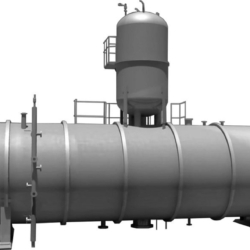The presence of undesired gases dissolved in liquid streams can give rise to operational problems. One specific example includes dissolved carbon dioxide which combines with water to form carbonic acid. This, in turn, leads to further corrosion issues. As another example, when feedwater contains high levels of dissolved oxygen, it leads to severe corrosion damage as it clings to the surfaces of metallic pipes and equipment, ultimately forming rust through the process of oxidation. Vacuum deaeration and gas striping deaeration both serve as two commercialized technologies in eliminating dissolved gases from liquid streams.
Vacuum Deaeration
Removing undesirable gasses via vacuum offers greater cost advantages compared to using chemicals for their removal. According to Henry’s law, the gas solubility is directly proportional to the partial pressure of the gas. Hence, as the pressure reduces, the solubility of the gas decreases accordingly. This principle holds true when dealing with combinations of gas and liquid in a solution. The operation of this deaerator involves a tower under vacuum condition. Random packings are typically employed to enhance the mass transfer. To establish a vacuum in the degassing tower, vacuum pumps, either with or without the assistance of additional air-driven ejectors are used.
Gas Striping Deaeration
This process uses a stripping gas stream to remove dissolved gas from a liquid stream. The low concentration of dissolved gas in the stripping stream creates a strong driving force for mass transfer, thereby reducing the concentration of dissolved gas in liquid. The liquid flows through a packed tower, countercurrent to the stripping gas, which is vented at the top of the column. Effective internal designs guarantee efficient transfer of dissolved gas from the liquid to the gas phase. The design is tailored to minimize gas consumption and enhance efficiency
